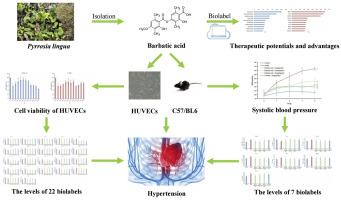Barbatic acid inhibits inflammatory responses and endothelial dysfunction in hypertension by regulating HIF1A/FLT1 pathway: A computer-aided biolabel research and experimental validation
IF 6.3
2区 医学
Q1 BIOLOGY
引用次数: 0
Abstract
Hypertension is a prevalent cardiovascular and cerebrovascular condition encountered in clinical practice. It has emerged as a significant global public health challenge and is the leading risk factor for mortality. Barbatic acid has a pharmacological basis for preventing and treating hypertension, including mechanisms such as diuresis and anti-inflammatory effects. However, its therapeutic potential and mechanism of action remain incompletely understood. The purpose of this study is to investigate the therapeutic potential and mechanisms of action of barbatic acid in the treatment of hypertension. Based on the biolabel-led research model, bioinformatics was employed to conduct a comprehensive analysis of the therapeutic potential, advantages, and mechanisms of action of barbatic acid in treating hypertension. Ang II was utilized to establish a hypertensive cellular model, while L-NAME was employed to create an animal model of hypertension, thereby validating the findings from the biolabel analysis. Bioinformatics indicates that ten biolabels are implicated in the anti-hypertensive mechanism of barbatic acid. The primary targets are HIF1A and FLT1, which primarily contribute to inflammatory responses and endothelial dysfunction. Cell experiments demonstrate that barbatic acid can effectively enhance the proliferation ability of HUVECs and adjust the levels of ten biolabels and downstream targets. Animal experiments demonstrate that barbatic acid can effectively reduce blood pressure in hypertensive mice, significantly ameliorate associated pathological damage in the heart, kidney, and thoracic aorta tissues, and inhibit HIF1A/FLT1 levels in these mice, thereby improving the inflammatory response and endothelial dysfunction. The verification confirmed the analytical results of the biolabel research model. Barbatic acid has the capacity to inhibit the inflammatory response and endothelial dysfunction in hypertension by mediating the HIF1A/FLT1 pathway.

巴巴多酸通过调节HIF1A/FLT1通路抑制高血压炎症反应和内皮功能障碍:计算机辅助生物标记研究及实验验证
高血压是临床上常见的心脑血管疾病。它已成为一项重大的全球公共卫生挑战,是导致死亡的主要风险因素。巴巴多酸具有预防和治疗高血压的药理基础,包括利尿和抗炎作用等机制。然而,其治疗潜力和作用机制尚不完全清楚。本研究的目的是探讨巴巴酸治疗高血压的治疗潜力和作用机制。基于以生物标签为主导的研究模式,采用生物信息学方法对巴巴酸治疗高血压的治疗潜力、优势及作用机制进行综合分析。采用Angⅱ建立高血压细胞模型,L-NAME建立高血压动物模型,验证生物标签分析结果。生物信息学研究表明,有10种生物标记物与巴巴酸的降压机制有关。主要靶点是HIF1A和FLT1,它们主要参与炎症反应和内皮功能障碍。细胞实验表明,巴巴酸能有效增强HUVECs的增殖能力,调节10种生物标记物和下游靶标的水平。动物实验表明,巴巴酸能有效降低高血压小鼠的血压,显著改善心、肾、胸主动脉组织相关病理损伤,抑制这些小鼠的HIF1A/FLT1水平,从而改善炎症反应和内皮功能障碍。验证验证了生物标签研究模型的分析结果。巴巴多酸具有通过介导HIF1A/FLT1通路抑制高血压炎症反应和内皮功能障碍的能力。
本文章由计算机程序翻译,如有差异,请以英文原文为准。
求助全文
约1分钟内获得全文
求助全文
来源期刊

Computers in biology and medicine
工程技术-工程:生物医学
CiteScore
11.70
自引率
10.40%
发文量
1086
审稿时长
74 days
期刊介绍:
Computers in Biology and Medicine is an international forum for sharing groundbreaking advancements in the use of computers in bioscience and medicine. This journal serves as a medium for communicating essential research, instruction, ideas, and information regarding the rapidly evolving field of computer applications in these domains. By encouraging the exchange of knowledge, we aim to facilitate progress and innovation in the utilization of computers in biology and medicine.
 求助内容:
求助内容: 应助结果提醒方式:
应助结果提醒方式:


